Many people live and recreate in areas shared with wolves. Generally shy, wolves tend to avoid contact with people, so many people may be unaware of their presence.
Wolves live in packs, or family groups that usually consist of a breeding pair and their offspring. Each pack occupies an area of land called a territory that can be about 30-650 square miles in size depending on the region and abundance of prey. Pups are born each spring and stay with the family for about one-and-a-half years before dispersing to find a mate and create a new territory.
Wolves occasionally come close to homes or worksites while in search of prey. Normally they move on without causing problems; however, occasionally wolves kill livestock or pets and/or become habituated to humans. In these cases, wolves are often removed from the population to avoid further conflict. With large predators such as wolves, it is important to avoid encouraging them to spend time near people or become dependent on food rewards.
The following guidelines may be useful in minimizing the chances of an unsettling encounter and developing habituation behaviors of wolves near homes or worksites.
WOLF SIGHTINGS
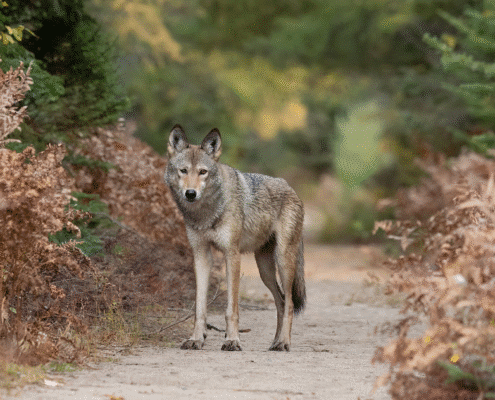
Sighting a wolf at close range in the wild is a rare occurrence
Sighting a wolf at close range in the wild is a rare occurrence; the wolf will most likely slip away at the first opportunity. Wolves are shy animals, but are also very curious by nature. It is not unusual for a wolf to “stand its ground” when it sees a human, much as a dog might. Rarely, one may even slowly approach a person, especially pups or yearling wolves that are curious.
Always remember to view wildlife on their terms. Watch from a respectful distance; use binoculars or a spotting scope. Your actions should not in any way change an animal’s natural behavior. Keep the following in mind:
- Do not approach wolves while on foot or from a vehicle.
- Do not allow a wolf to approach closer than 300 feet.
- Do not entice them to come closer with food or by howling.
- Leave room for the wolf to escape your presence.
- If wolves are near your home, consider installing motion sensor lights or noise boxes to discourage wolf activity near your property.
Occasionally, a person stumbles into the pack’s summer rendezvous site where the pups are located. This may cause nearby adult wolves to bark and/or howl. Barking is a signal that the wolf is upset or feeling threatened. Use this as a signal to leave the area.
Attacks by wolves on humans are rare, but they have occurred. If a wolf approaches at a close distance without fear, or acts aggressively with ears erect, growling or snarling, take the following actions:
- Do not run – predators instinctively chase running animals.
- Raise your arms and wave them in the air to appear larger.
- Back away slowly, do not turn your back on the wolf.
- Shout, make noise and throw objects at the wolf.
- Climb a tree or large rock if necessary.
DO NOT FEED WOLVES
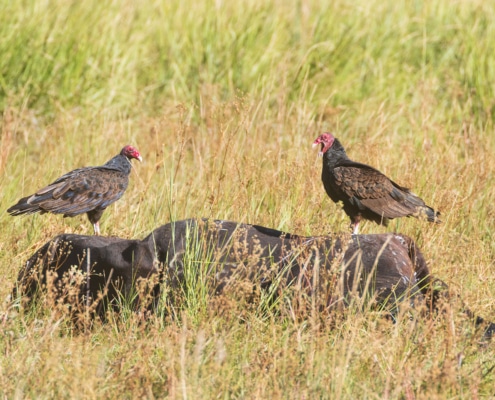
Dispose of dead livestock quickly per state guidelines to prevent scavengers.
Wolves are opportunistic predators, and in their search for food, they follow their nose.
- Avoid leaving any type of human or pet food, garbage, or other bait/feed (such as suet, corn, or sunflower seeds) outside or in unsecured containers.
- Hunters and trappers should avoid leaving carcasses or remains near human dwellings.
- Dead livestock should be quickly disposed of, following state guidelines or laws, and not left where they are accessible to wolves and other scavengers.
PETS IN WOLF COUNTRY
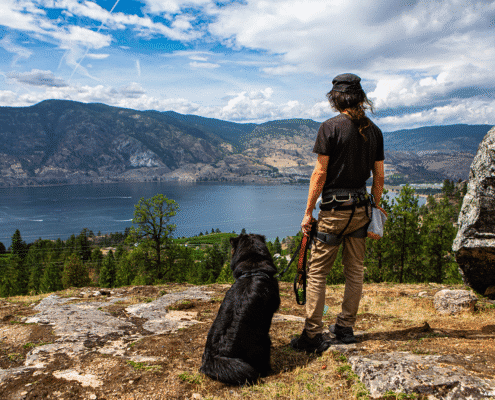
Always monitor your pets and keep them within visual range with voice control or on a leash.
Wolves defend their territory from other wild canid intruders, such as neighboring wolf packs and coyotes. Because of this instinct to defend their territory, wolves sometimes kill or injure dogs. Free-ranging dogs, including hunting hounds, are at the greatest risk because they are not under the direct control of their owners.
- Always monitor your pets and keep them within visual range with voice control or on a leash.
- Do not leave pets unattended.
- Avoid areas that have a recent history of wolf-dog conflicts or wolf activity such as fresh scat or tracks.
- Make noise while hiking or hunting with dogs to alert wolves that humans are nearby.
- Do not allow dogs to scavenge deer remains. Wolves often scavenge deer remains and defend this important food source.
- If you believe your pet has been injured or killed by a wolf, preserve evidence such as tracks. Contact the appropriate authority as soon as possible (see below for contact information).
HUNTING IN WOLF COUNTRY
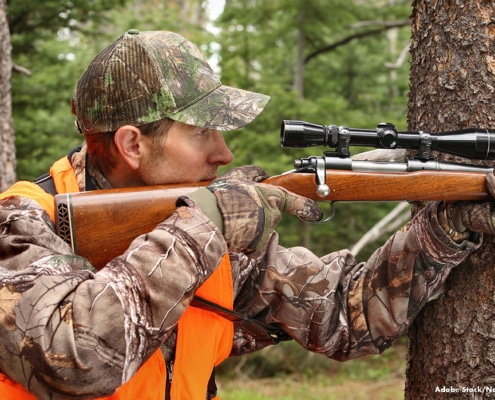
Hunters using camouflage may encounter wolves near their prey.
Hunters may find themselves near wolves, especially hunters that use camouflage to conceal themselves or the scents or calls of animals that wolves typically hunt. Trappers occasionally catch wolves in their traps, and predator hunters may call wolves in with predator calls.
- Place buck or doe hormone scent on inanimate objects such as a stump or clump of brush. Do not douse yourself with scent.
- The use of animal calls or decoys may attract a wolf or wolf pack in for a closer inspection.
- Do not clean wild game and fish in heavily used areas such as campgrounds and hunting access areas.
- Do not release hounds near bait piles that have been heavily used by wolves.
- Recover all hunting hounds released during a chase on the same day.
Remember: If you are wearing camo and covering up with deer scent, wolves will have a more difficult time distinguishing you as a human, and you may need to be especially vocal and animated to scare off approaching wolves. In recent years, several hunters have had close encounters with wolves. None of these hunters were harmed, and all reported that once the wolf or wolves were aware of their presence, they quickly retreated, leaving the hunter awed (and sometimes a little unnerved) by the experience.
CAMPING IN WOLF COUNTRY
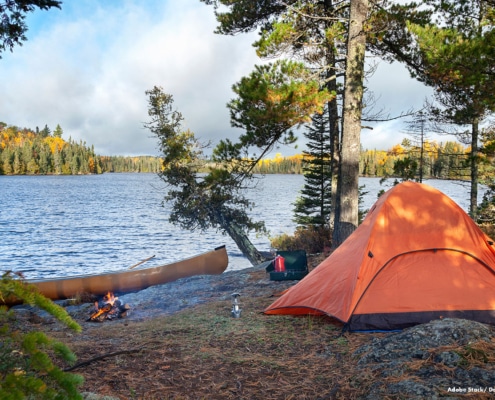
Wolves are rare near campgrounds; messy sites can attract them and other wildlife.
Wolves that stay close to campgrounds are rare; however, untidy campsites where food scraps remain are known to attract a wide variety of wild animals, which sometimes include wolves. Campers should remember to:
- Cook, wash dishes and store food away from sleeping areas.
- Pack out or dispose of garbage and leftover food properly.
- Suspend or pack food, toiletries and garbage out of reach of any wildlife.
- Do not sleep in the same clothes used while cooking.
- Always keep pets near you.
- Immediately report any wolves sighted within a campground to the proper authorities.
Additional Information for Living with Wolves
- Know wolf signs and educate yourself about wolves when living or recreating in wolf country.
- Wolves may be protected by state or federal laws, and it may be unlawful to kill or injure a wolf except in defense of human life.
- Have telephone numbers of local wildlife officials handy if you incidentally capture a wolf in a trap set for another species. State natural resource personnel can assist in removing a wolf from a trap and may be interested in radio collaring the animal.
- Report an incident, accidental shooting, or poaching of a wolf:
Wisconsin Department of Natural Resources (WDNR)- (800) 847-9367 or Information – 888-936-7463
Michigan Department of Natural Resources (MIDNR) RAP (Report All Poaching) – 800-292-7800
Minnesota Department of Natural Resources (MDNR), TIP (Turn in Poachers) – 800-652-9093 or Information Center 888-646-6367

The International Wolf Center uses science-based education to teach and inspire the world about wolves, their ecology, and the wolf-human relationship.
